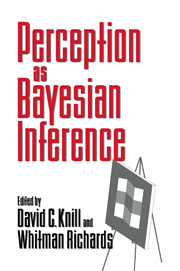Book contents
- Frontmatter
- Contents
- List of contributors
- Preface
- 0 Introduction
- Part one Bayesian frameworks
- Commentaries
- Part two Implications and applications
- 6 Implications of a Bayesian formulation of visual information for processing for psychophysics
- 7 Shape from texture: Ideal observers and human psychophysics
- 8 A computational theory for binocular stereopsis
- 9 The generic viewpoint assumption in a Bayesian framework
- 10 Experiencing and perceiving visual surfaces
- 11 The perception of shading and reflectance
- 12 Banishing the homunculus
- Commentaries
- Author index
- Subject index
9 - The generic viewpoint assumption in a Bayesian framework
Published online by Cambridge University Press: 05 March 2012
- Frontmatter
- Contents
- List of contributors
- Preface
- 0 Introduction
- Part one Bayesian frameworks
- Commentaries
- Part two Implications and applications
- 6 Implications of a Bayesian formulation of visual information for processing for psychophysics
- 7 Shape from texture: Ideal observers and human psychophysics
- 8 A computational theory for binocular stereopsis
- 9 The generic viewpoint assumption in a Bayesian framework
- 10 Experiencing and perceiving visual surfaces
- 11 The perception of shading and reflectance
- 12 Banishing the homunculus
- Commentaries
- Author index
- Subject index
Summary
Introduction
A task of visual perception is to find the scene which best explains visual observations. Figure 9.1 can be used to illustrate the problem of perception. The visual data is the image held by two cherubs at the right. Scattered in the middle are various geometrical objects – “scene interpretations” – which may account for the observed data. How does one choose between the competing interpretations for the image data?
One approach is to find the probability that each interpretation could have created the observed data. Bayesian statistics are a powerful tool for this, e.g. Geman & Geman (1984), Jepson & Richards (1992), Kersten (1991), Szeliski (1989). One expresses prior assumptions as probabilities and calculates for each interpretation a posterior probability, conditioned on the visual data. The best interpretation may be that with the highest probability density, or a more sophisticated criterion may be used. Other computational techniques, such as regularization (Poggio et al., 1985; Tikhonov & Arsenin, 1977), can be posed in a Bayesian framework (Szeliski, 1989). In this chapter, we will apply the powerful assumption of “generic view” in a Bayesian framework. This will lead us to an additional term from Bayesian theory involving the Fisher information matrix. (See also chapter 7 by Blake et al..) This will modify the posterior probabilities to give additional information about the scene.
Information
- Type
- Chapter
- Information
- Perception as Bayesian Inference , pp. 365 - 390Publisher: Cambridge University PressPrint publication year: 1996
Accessibility standard: Unknown
Why this information is here
This section outlines the accessibility features of this content - including support for screen readers, full keyboard navigation and high-contrast display options. This may not be relevant for you.Accessibility Information
- 5
- Cited by
